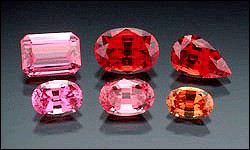SPINEL - The Natural GEM, - NOT just a synthetic imitation
It is unfortunate that most people associate the name "spinel" with cheap synthetic stones and "birthstone imitations" as are typically sold jewelry stores. Literally tons of man-made spinel are produced in factories each year, and this imitation synthetic is all most people know of spinel. This association has become so pervasive that it is not widely realized that spinel is actually a hard, durable, natural gemstone that occurs in a range of colors large enough to rival sapphire! Because of its rarity, many folks have never even seen the real thing - natural spinels are rarely found in normal jewelry stores. In fact, that rarity is main thing holding back spinel from greater recognition and demand. Fine spinels are now more rare than the rubies they used to imitate. Strangely, they are also more affordable, because in the gem world, being too rare can be a drawback because so few people ever get a chance to grow to love these beautiful gem varieties. So If you want a genuine, natural gem with the color and very nearly the hardness of a sapphire or ruby at a quarter of the price, Spinel is your stone.
Moreover, spinel is usually less included than ruby and sapphire,
comes in larger sizes, and wears just as well in jewelry. Yet spinel costs a fraction of the price of a
comparably colored corundum gemstone. This discrepancy is even more striking when it is
realized that spinel is, in its finest grades, at
least as rare as ruby and sapphire of comparable hue. Spinel is the
insider's “secret
bargain” of the gemstone world because of its high quality, beautiful
colors and low prices.

The Natural Imposter
Spinel is the great imposter of gemstone
history: many fine historic red spinels have been confused for rubies. Even when people
learned that gems of the same color are not necessarily the same kind of material, they
still had difficulty separating red spinel and ruby. Not only do the two gems have the
same color and fluorescence, but they are often found together in the same mines, and
ruby's physical properties are very similar to spinel's; ruby is only slightly more dense
and slightly harder. As an example, the
so-called "Black Prince's Ruby" in the Crown Jewels of England is actually a
large, a magnificent 160-carat red spinel. Spinel
also occurs in spectacular colors of pink, violet, blue and orange. Green spinels are rare,
and colorless stones are virtually nonexistent. The
intense, rich hues of these gemstones, combined with their great rarity and extremely low
price, make them natural selections for long-range appreciation and an integral part of
well-diversified gem investment portfolios.
Only now is natural spinel starting to be
fully appreciated for its own sake, it is becoming a favorite of gem dealers and gem
collectors due to its combination of brilliance, hardness and wide range of spectacular
colors and great price. In recent years its price has begun to steadily
increase as it has become better known and appreciated among gem collectors. Spinel is only slightly softer than corundum, and like it has no
cleavage and is among the most durable of all gemstones. Diamond is the hardest of
all substances (10) in the gemstone world; next in line are ruby and sapphire (both 9 on
the hardness scale), followed by spinel (8 1/2). Because of this, spinel is perfect for
all jewelry uses, including rings which are worn daily.
Spinel also comes in beautiful blues which are sometimes called
cobalt spinel, but these are rare. In addition to Burma, now known as Myanmar, spinel is
also mined in Sri Lanka, Thailand, Pakistan, Tanzania, and Tadjikstan, a part of the former Soviet
Union. Because of the geology of spinel formation, most of the gems are
widely dispersed in their mother rock - as the rock weathers, the spinel
accumulates in gravel deposits derived from these rocks. Spinel is hard and
durable, so most gem spinels are mined as gravels from from these alluvial occurrences. The Mogok
area in upper Burma is the source of the finest quality spinels where they occur in a
variety of colors, including red, pink, violet, orange, blue and rose. Recent discoveries in the Tundru region of Tanzania
in East Africa have produced some beautiful sapphire and teal colored blue spinels
- in these deposits, sapphire and spinel occur together and sometimes
require gemological analysis to separate. Some of the Tunduru area spinels
rival the finest blue colors of sapphire. This is in marked contrast to some
Asian blue spinels which appear muddy. From another deposit, Tanzania
also produces a bright pink to pink-orange Spinel.
Color, clarity and weight are the most important consideration in evaluating a spinel's quality. Red is the most valuable color, followed by orange red, pinkish red and purplish red. As spinel is commonly flawless, so the clarity of the stone is a much more important consideration than in Ruby. Another fact to the benefit of spinel is that nearly all spinel gems are natural and untreated. This is in direct contrast with most Ruby and Sapphire which are treated with intense heat. Usually color and clarity are already good in the crystals as mined, so little if any Spinel is treated to change its color, or improve its clarity.
